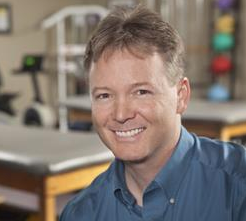
Shoulder pain is one of the most common complaints we resolve on a daily basis, but the actual pain may not be coming from your shoulder (see testimonial videos at the bottom of the article.)
You're about to discover the causes of shoulder pain that are often missed, and you'll also learn what to do in the event that you or someone you care about experiences shoulder pain.
Rotator cuff problems are most common in people from the ages of 45 to 65, and the typical cause is unknown and it's gradual. There are cases where there is a direct cause such as a fall or a lifting injury; however, most shoulder pain cases present with the "I don't know what happened" mechanism of injury.
Your Physical Therapist (Doctor of Physical Therapy) can help you on your way to getting rid of your shoulder pain first by administering a proper examination. Keep in mind that your Physical Therapist (PT) works hand in hand with your Physician and/or Nurse Practitioner. PT's are trained as independent specialists in evaluation and treatment of neuromusculoskeletal problems (nerve, muscle, joints, connective tissue). If you see a PT first, they will know when to refer for medical testing. If you see your Physician or Nurse Practitioner first, they typically know when to refer you to Physical Therapy. State laws vary, so to keep it simple, I recommend you contact the medical provider you have the best relationship with so they can guide you.
Shoulder pain treatment depends strongly on getting a proper diagnosis and assessment. Let's look a a few reasons you need a true expert to help you with your shoulder pain.
1. Did you know that all rotator cuff tears do not need surgery? A large percentage of the population are walking around with rotator cuff tears and they do not have pain or other problems. Anywhere from 7%-40% of the population could be walking around with a full rotator cuff tear! http://www.wheelessonline.com/ortho/rotator_cuff_tears_frequency_of_tears
2. Gallbladder problems can cause shoulder pain: http://www.loomisenzymes.com/articles/the-gallbladder-syndrome.aspx
3. Certain postures can lead to rotator cuff tear both with and without symptoms: http://www.ncbi.nlm.nih.gov/pubmed/25441565
4. Lung and pancreatic problems can refer pain into the shoulder
5. A frozen shoulder can cause pain and stiffness, and it's often mistaken for tendinitis or bursitis.
6. Second Rib Syndrome is often mistaken for Impingement Syndrome as it mimmicks the symptoms perfectly and it tests positively for impingement.
7. Certain types of acromion processes (Type I, II, or III), the bone above the ball/socket, can act like spurs cause rotator cuff damage.
8. Certain neck and spine problems can cause shoulder pain. We see at least 1 patient a month with a diagnosis of shoulder pain, and our testing shows that it comes from the neck. Without a proper Physical Therapy Exam, these patients would not get better with treatment for shoulder pain.
Of course there are more problems that can lead to shoulder pain, but the point is that you need to forego assumption and a quick opinion from a friend and get a true examination done. If you choose to jump on the internet and google your symptoms, then you will be thoroughly confused and misguided many times. Avoid this as you will be wasting valuable time when you can go directly to your practitioner and start getting something done specifically for your problem. Having treated thousands of shoulder problems, I can attest that the internet has not helped any of my patients get better. At best, it scared them to go to their medical practitioner to be tested.
Do You Need and MRI for Your Shoulder Pain?
Aside from an obvious trauma, typically an MRI is done when conservative treatment is not working. Conservative treatment involves any medication and/or injection your physician may perform and physical therapy treatment by a Doctor of Physical Therapy.
When you undergo Physical Therapy Treatment, you may have 6-12 visits (our average) depending on your problem. The cost of this entire course of therapy is less than half of what it costs for an MRI! So why waste time and money on a test that is going to do nothing to get you better. Even if you end up needing surgery, the therapy you do actually helps you be better prepared for the procedure, and you will recover faster afterward.
One secret that many PT's who specialize in treating orthopaedic conditions know is that if there is a 50% weakness in a particular muscle, there is a 90% chance you have a tear. If you don't respond to treatment relatively fast (pain decrease, strength increase, and an increase in your range of motion), then your PT will refer you to your MD for further testing such as an MRI.
Treatment for Shoulder Pain
Once systemic sources of pain have been ruled out, and your shoulder pain is coming from a mechanical problem, your PT will test your shoulder first by asking a series of questions about your shoulder's pain behavior. Many shoulder conditions have a certain pain pattern such as pain at night, pain reaching into the back pocket, pain/stiffness with fastening your bra, or just points of pain with certain reaching positions.
Once your PT has determined your type of shoulder pain, observed your posture, observed the appearance of your shoulder complex, then the fun part begins - motion tests, strength tests, and special tests.
All of these tests are done to get an accurate assessement of what the problem is. Treating pain is not hard to do, but you want your hard earned money spent on a clinician who is going to target and treat the problem - the source of your pain.
Generally, a specific regimen of therapeutic exercise and manual therapy strategies are employed. Hands on treatment yields better outcomes when combined with exercise vs exercise alone. If you are in a therapy program, and no hands-on work has been done, then you aren't getting the full monte of what's proven and available.
A home care program is also designed. This may be a few movements and positions designed to work to heal your shoulder in concert with your clinical program. You should also be given the do's and the dont's regarding your activities.
Specific goals will be set for you to achieve relating to your pain, strength, motion, and function; and once your goals are being achieved then you are weaned to self care. Depending on your stage of healing and recovery, your PT will give you instructions on what to do and how long to do it once you are discharged from clinical care.
Initial goals are things like sleeping through the night, full active range of motion without pain, slight strength increase, and being able to drive or do other household activities without pain. The long term goals have to do with getting you back to full function whether you are a pro baseball pitcher or someone who enjoys gardening. Your PT will also have measurements they use to determine the status of your healing and how best you need to take care of it.
Your Amazing Shoulder
Your shoudler is your most mobile joint in your body, and that's why it requires more strength and stability from the multitude of surrounding muscles and ligaments. Their is an intricate balance required to ensure that your ball and socket joint moves smoothly. Imagine a golf ball sitting on a tee -- and now it needs to be secured on that tee to where it can roll around perfectly.

That's the job of the muscles (especiall the rotator cuff) and the ligaments that hold the ball in the socket. All it takes is just one little problem in one of these muscles and the balance is thrown off - friction results - inflammation follows = pain.
Your shoulder is a complex set of nerves, bones, ligaments, tendons, and muscles all set to provide a base from which you should be able to move your arm in a variety of ways. We take these things for granted until a little something goes wrong and then our world changes. Don't hesitate to see your Physical Therapist when your shoulder isn't allowing you perform in life like you want.
Finding the Best Specialist for Your Shoulder
If you are in an area where you don't have access to a Physical Therapist or another specialist that can help you, or if you simply need help selecting the best specialist for you, GO HERE or fill out the form below, and we can help you. We will personally look at your situation and seek the best specialist for your particular problem - For FREE!
Yours in Health,
Dr. Wade Baskin, PT, DPT, Cert. SMT, Cert. DN, RRT
Doctor of Physical Therapy
Executive Director
662-773-3700
